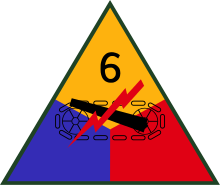|
6th Armored Division (United States)
The 6th Armored Division ("Super Sixth"[1]) was an armored division of the United States Army during World War II. It was formed with a cadre from the 2nd Armored Division. History  TrainingThe 6th Armored Division was activated on 15 February 1942 at Fort Knox, Kentucky. The major elements of the division originally were the 68th and 69th Armored Regiments and the 50th Armored Infantry Regiment; the 68th Armored Regiment had originally been part of the 1st Armored Division, while the 69th Armored Regiment had been part of the 2nd Armored Division. Brigadier General Carlos Brewer was assigned as the division's first commanding general.[2] It moved to Camp Chaffee on 15 March 1942 to make way for other Armored units, and then completed its assembly and unit training. The division then participated in the VIII Corps Louisiana Maneuvers from 25 August 1942, and then returned to Camp Chaffee on 21 September 1942. The 6th AD then moved to Camp Young at the Desert Training Center on 10 October 1942, and participated in the first California Maneuvers. ReorganizationThe 6th AD then moved to Camp Cooke to continue its training, where it was reorganized in September 1943, losing its "heavy" organization of two armored regiments and one armored infantry regiment in favor of a "light" organization of three tank battalions and three armored infantry battalions. Maj. Gen.[3] Robert W. Grow assumed command of the Division at Camp Cooke, California in May 1943 and commanded the division through the war until 30 July 1945. The 6th AD then staged at Camp Shanks, New York on 3 February 1944, departed the New York Port of Embarkation on 11 February 1944, and arrived in England on 23 February 1944. After continuing its training in England, 6th AD landed on Utah Beach in Normandy on 19 July 1944 as a follow-on unit, and went on the offensive as separate combat commands in the Cotentin Peninsula in support of the Normandy Campaign. CompositionThe division was composed of the following units:[4]
Combat chronicleAt the end of the Normandy Campaign, 6th AD assembled at Le Mesnil on 25 July 1944. 6th AD then passed through 8th Infantry Division to clear the heights near Le Bingard on 27 July 1944, and Combat Command A secured a bridgehead across the Sienne (river) near Pont de la Roque on 29 July 1944, and overran Granville on 31 July 1944. 6th AD then returned to Avranches, where it relieved 4th AD and secured the area bridges. In mid-August in Europe, the 6th Armored Division moved down to Lorient, where it was relieved by the 94th Infantry Division in September. Elements of the division participated in the Battle for Brest (7 August - 19 September 1944). The 6th then turned east and cut across France, reaching the Saar in November. It crossed the Nied River on 11–12 November, against strong opposition, reaching the German border on 6 December, and established and maintained defensive positions in the vicinity of Saarbrücken. On 23 December, the division was ordered north of Metz to take part in the Battle of the Bulge, and took over a sector along the south bank of the Sauer. The 6th was heavily engaged in the battle for Bastogne, finally driving the enemy back across the Our River into Germany by late January 1945. After a short period of rehabilitation, the division resumed the offensive, penetrated the Siegfried Line, crossed the Prum, reached the Rhine River at Worms on 21 March, and set up a counterreconnaissance screen along its west bank. The 6th crossed the Rhine at Oppenheim on 25 March, drove on to Frankfurt, crossed the Main, captured Bad Nauheim, and continued to advance eastward, and surrounded and captured Mühlhausen on 4–5 April. After repulsing a light counterattack, it moved forward 60 miles to cross the Saale River and assisted in freeing Allied prisoners of war and the German concentration camp at Buchenwald. The division raced on, took Leipzig, crossed the River Zwickau Mulde at Rochlitz on 15 April 1945, and stopped, pending the arrival of the Red Army. Defensive positions along the Mulde River were held until the end of hostilities in Europe. The division arrived at Camp Shanks, New York on 18 September 1945 and was inactivated. Casualties
Post-World War IIThe division was reactivated at Fort Leonard Wood, Missouri on 5 September 1950 in response to the Korean War, and served as a training division until inactivation on 16 March 1956. 6th Armored Division (Training) organization at Fort Leonard Wood:
Official historyAt the end of World War II, two 6th Armored Division G3 officers, Majors Paul L. Bogen and Clyde J. Burk along with Aide-de-Camp Captain Cyrus R. Shockey, compiled a Combat Record of the Sixth Armored Division in the European Theatre of Operations 18 July 1944 – 8 May 1945. The official history by George F. Hofmann, The Super Sixth: History of the 6th Armored Division in World War II (1975, reprinted 2000)[6] has been called by World War II scholar Martin Blumenson, a "first-rate military history." He also noted that General Patton called the 6th AD one of the two best divisions in his Third Army.[7] References
External links
|
||||||||||||||||||||||||||||||||
